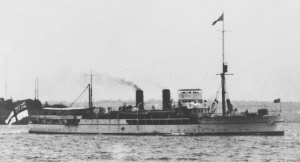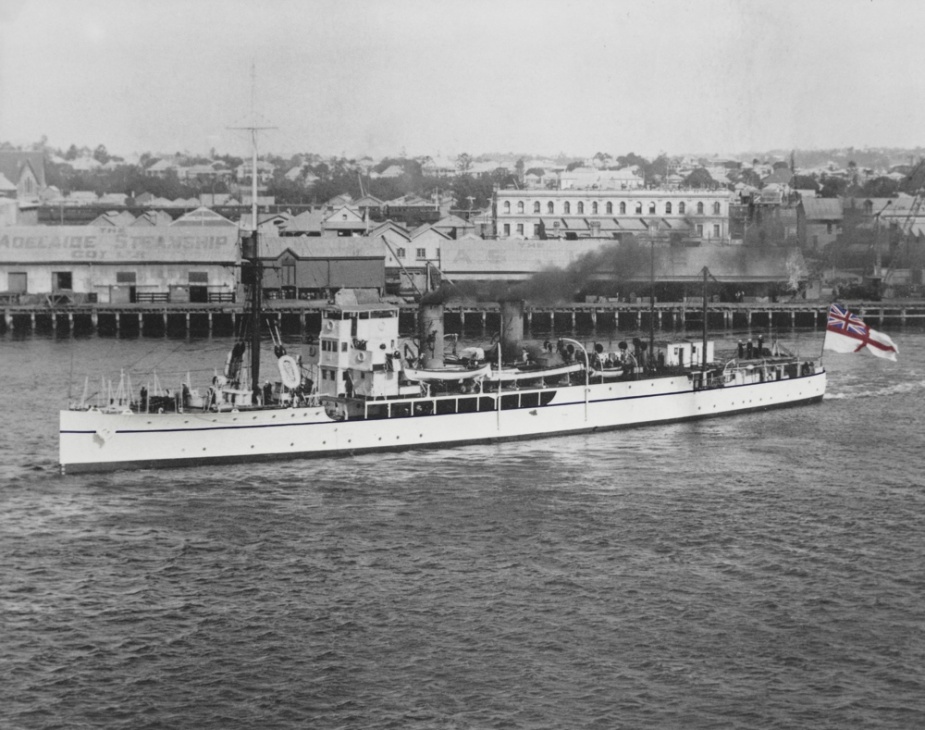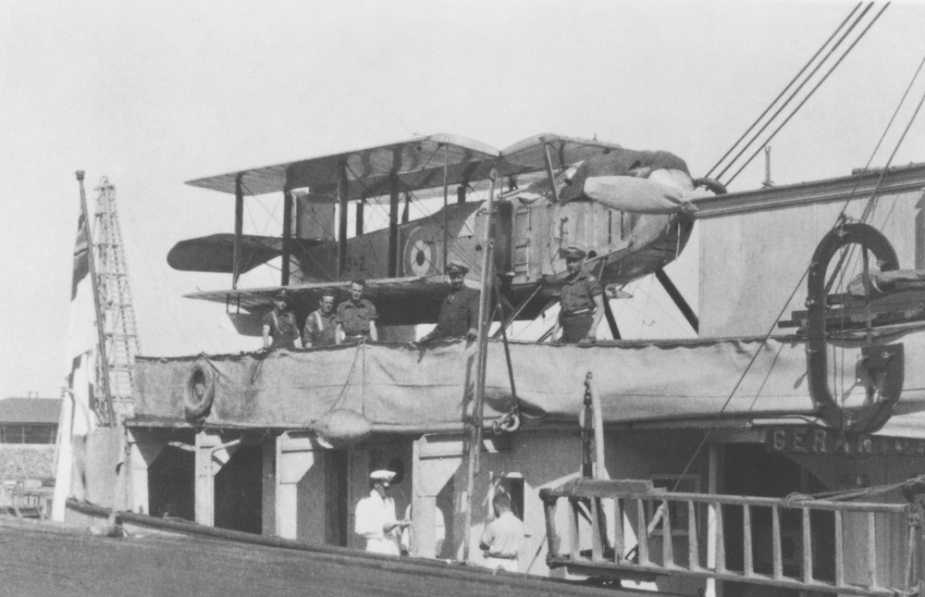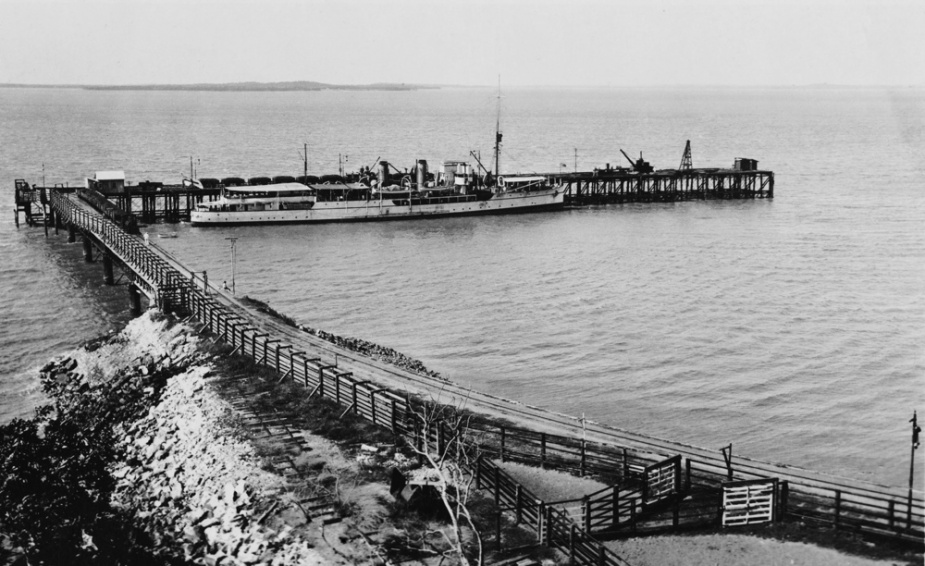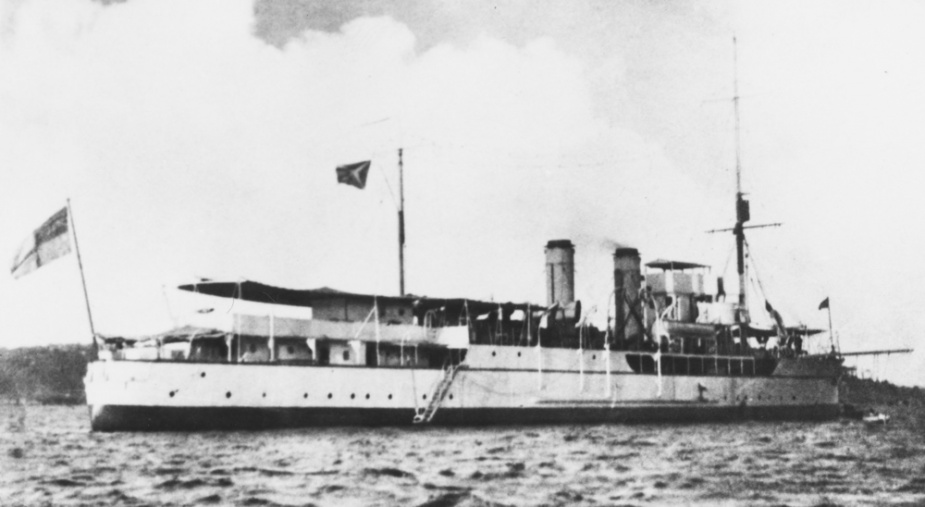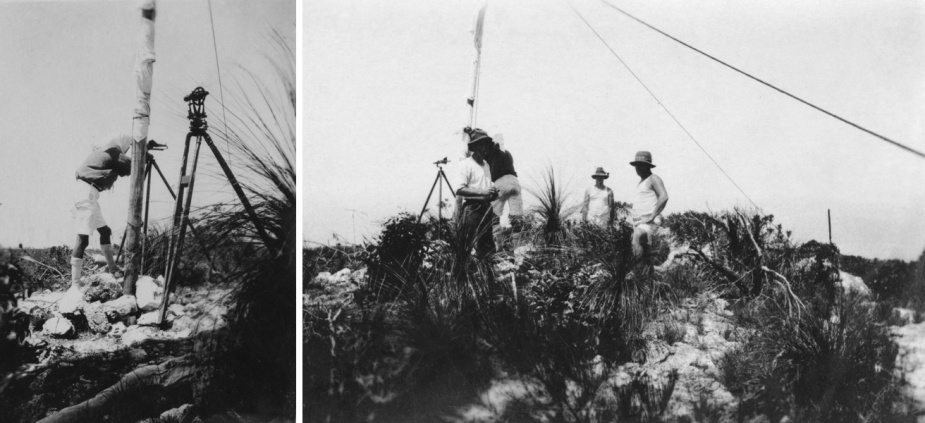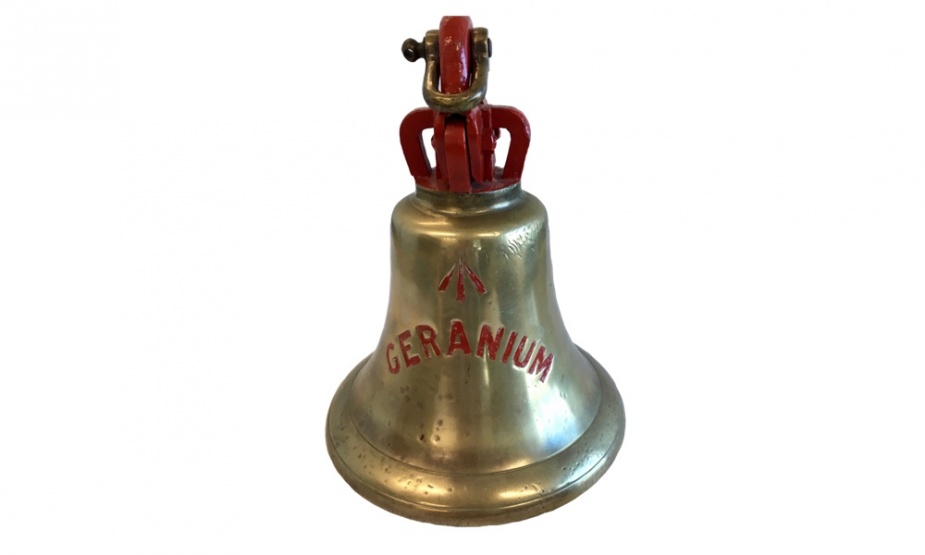HMAS Geranium - Part 2
| Class |
Flower Class |
|---|---|
| Type |
Sloop |
| Nickname |
Gerger |
| Motto |
Pelargonium Nil Desperandum – Geraniums Never Despair |
| Builder |
Greenock and Grangemouth Company |
| Launched |
8 November 1915 |
| Commissioned |
14 February 1920 |
| Decommissioned |
10 November 1927 |
| Fate |
Sunk off Sydney Heads on 16 April 1935 |
| Dimensions & Displacement | |
| Displacement | 1250 tonnes |
| Length | 267 feet 9 inches |
| Beam | 33 feet 6 inches |
| Draught | 11 feet |
| Performance | |
| Speed | 16.5 knots |
| Armament | |
| Guns |
|
The ship's first cruise for the year was south to Tasmania. Geranium departed Sydney on 18 March 1924 and arrived at Fosters Inlet on the 20th. She operated in this area for the next eight weeks and also surveyed the entrance to the River Tamar. She grounded at MacArthur River on 3 April but was refloated and repairs conducted at Launceston during 4-7 April. She visited Burnie during 7-8 April and on 10 April she landed an observation party, by whaler, at Emita Point on Flinders Island to confirm the exact position of the wireless telegraphy mast; for use as a navigational fixing position.
The weather deteriorated so the ship moved from Rabbit Island to anchor in the lee of Hummock Island. The weather remained bad and the observation party, including the Commanding Officer, were not recovered until 14 April. They had to spend the first night ashore on beach with a driftwood fire for warmth while high winds lashed the coastline. The next day they sought shelter in a farmhouse before being picked up on the fourth day. In the meantime Geranium had been damaged with guard rails torn away and boats damaged.
To recover the observation party ashore those on board the ship floated a barrel, on a cable, to within 275 metres of the shore line and those ashore rowed the whaler out to it, hooked on and were then hauled back to ship. Geranium returned to Sydney on 17 April and remained alongside until late June for repairs and to convert the data gained into charts, tide tables and other navigational resources.
Also while in Sydney Geranium was fitted out, in early June, to carry Royal Australian Air Force (RAAF) Fairey IIID seaplane: the first RAN survey vessel to carry an aircraft. The deck area, above the superstructure at the stern, was enlarged and wooden chocks and tie-down points were fitted to secure the aircraft. Welded storage tanks for aircraft and motor boat fuel were fitted on the stern and additional accommodation was built on the upper deck for the RAAF personnel and for scientists embarking during the survey. A Fairey IIID was dispatched to Sydney, from Point Cook in Victoria, for trials of the ship’s deck and securing arrangements.
The plan was for Geranium to embark one seaplane, one motor boat as a tender to the aircraft, two officers (one pilot and one observer) and nine airmen (three photographers, two riggers, two engine fitters, a motorboat coxswain and a storeman). Once the trials were completed it was found that the aircraft, when stored on deck, affected the ship’s stability and the decision was made to fly the aircraft to Townsville once Geranium had arrived there.
For various reasons the RAN had forsaken the carriage of aircraft in its light cruisers, but using aircraft at sea in connection with hydrographic surveying of the Great Barrier Reef was considered viable. This region was of particular interest for the Australian Government as detailed knowledge of the Reef was sparse and there were significant shipping routes that required regular survey to allow for safe navigation. Additionally the Great Barrier Reef Committee had been formed in 1922 with funding allocated by the Federal Government for research and conservation of the reef. The eastern (outer) limit had been generally delineated and the inner navigable channel had been surveyed to varying standards of reliability. Between the inner channel and the outer edge lay unknown waters with a few poorly surveyed channels. Existence of other channels through the Reef was suspected and the activities of Japanese nationals, in the local pearling fleet, indicated that knowledge regarding channels through the reef may have been communicated to the Japanese Government.
The concept of using aircraft for surveying was widespread at the time and in 1923 a chart of Western Port was prepared with aerial photographic assistance. The RAAF opinion was that aircraft could expedite the survey of the Great Barrier Reef by photographing large areas that were difficult to access by conventional hydrographers. A combined service meeting held in January 1924 decided that the RAAF would assist during the next northern survey season and that the area immediately south of Cairns should be surveyed. This region was selected because of the narrowness of the reef, its proximity to the mainland, recent completion of some triangulation by HMS Fantome and the availability of good bases ashore for the aircraft.
On 23 June 1924 Geranium sailed from Sydney bound for the north Queensland coast. She conducted initial survey preparation work in the vicinity of Townsville and Cairns during July. On 15 July Geranium was en route from Townsville to Cairns when Stoker Clyde Eric Frederickson was lost overboard near Russell Island (south of Cairns). The ship had anchored for the night of 14/15 July about 700 metres off Russell Island due to bad weather. Frederickson was last seen at 7am on the morning of the 15th, when the ship was being moved to the lee side of High Island (to the north), due to increasing bad weather and heavy rain.
Fredrickson did not report for work later that morning and a thorough search of the ship failed to locate him. Russell and High Island were not searched due to the inclement weather and the subsequent ship’s board of enquiry returned a verdict of death by misadventure due to slipping overboard during bad weather. Other theories put forward by the ship’s company included suicide and even an elaborate desertion scheme as Frederickson was known to be a very strong swimmer and no money was found in his locker even though the crew had only recently been paid. His body was never recovered.
The RAAF detachment did not sail north on board Geranium and instead embarked as passengers in the SS Canberra which arrived in Townsville on 1 August 1924. The Fairey IIID aircraft (A10-2) departed RAAF Base Point Cook on 1 August flown by Flight Lieutenant Ivor McIntyre with Corporal (Mechanic) George Gottschalk to assist. After refuelling at Sydney, Southport and Gladstone, the aircraft reached Townsville on 4 August where Geranium was waiting. Townsville was also to become the ship’s main coaling base for the survey period. On arrival McIntyre handed the aircraft over to Flight Lieutenant Ernest Mustard, DFC (who later changed his surname to Mustar) and Flying Officer Thomas Swinbourne who would operate the aircraft for the next four months.
Geranium’s next period at sea was from 5 to 15 August and, although she did not embark the aircraft, Mustard twice flew the aircraft out and alighted alongside Geranium to report reef locations. Aircraft fuelling arrangements were successfully tested and the seaplane and RAAF personnel were finally embarked during 15-18 August at Townsville and thereafter operated from Geranium.
The aircraft served several purposes. The first was to carry out reconnaissance over parts of the Great Barrier Reef to gain a general idea of the reef layout and water depth for surveying purposes and to ensure the safety of the ship. In this role the aircraft was an immediate and unqualified success - Geranium’s Commanding Officer reported that a seaplane was essential for ship safety when working inside the Barrier Reef where the possibility of finding a reef by striking it was a permanent concern (as Bennett knew all too well from his experiences in the Gulf of Carpentaria in 1923). The aircraft was good for locating winding passages but the photographs conveyed little information about depths which all had to be sounded by lead line or sounding machine.
Secondly aerial photography was of some use to hydrographers. A photographic height of 10,000 feet (3050 metres) was selected to ascertain if vertical photographs could be joined to form a chart. The reefs in this area however were too far apart for this plan to be workable, but aerial photographs proved useful in preparing charts of individual reefs because submerged parts of the reef were visible in prints. Over the next four months Geranium and the RAAF detachment surveyed 19 reefs from Maori Reef (near Cairns in the north through to Ellison Reef, near Mission Beach, in the south). This was an area of over 2000 square kilometres surveyed although only half of this was done completely. Some of the new features discovered were named after the aircrew including Mustard Patches, Swinbourne Patches and Raaf Shoals and these features still appear on charts to this day. Despite the use of the aircraft much of the surveying work continued to be done using normal procedures.
Commander Bennett was convinced that seaplanes were an asset to hydrographers but he was equally sure that the Fairey IIID was unsuitable because of the restricted field of view from the cockpit and the fragility of the aircraft floats. Geranium’s movements had also been too restricted by the aircraft's need to take off and alight in the lee of reefs, and the necessity for the ship to remain near a suitable alighting area while the aircraft was airborne. The aircraft was stowed on board Geranium with wings folded on a platform right aft and when required was hoisted into the water by a derrick.
The hoisting arrangements worked well but calm water conditions were required to launch and recover the seaplane. Bennett stated an improved derrick would need to be fitted to allow the ship to be under while launching and recovering the aircraft. Additionally he stated the motor boat provided by the RAAF was too slow and cumbersome to be of real use in aircraft operations and the number of air force support personnel embarked in the ship was excessive.
In late September Geranium was placed on standby to proceed to the Gulf of Carpentaria to conduct a search, with her aircraft, for survivors from the 330 ton steamship Douglas Mawson. The vessel had been lost in a storm off Groote Eylandt on 23 March 1923 with all 20 people believed to have perished. In late 1924 rumours began to circulate that two women who had been on board had survived and were now “in the hands of blacks” (Sydney Sun, 22 September 1924). Commander Bennett later commented that it was highly unlikely there were any survivors from the Douglas Mawson and no search took place.
Overall the 1924 survey season had been successful although on 10 November Geranium grazed a coral outcrop on the survey ground north of Palm Island but sustained no damage. She commenced her return to Sydney on 3 December calling at Brisbane during 7-11 December and reaching Garden Island on the 13th. Christmas leave was granted and the ship remained in port undergoing maintenance until early April of the following year.
1925
Geranium sailed from Sydney on 11 April 1925 bound for surveying in northern Australian waters. After calling at Townsville and Cairns Geranium arrived at Caledon Bay in Arnhem Land on 23 April. It was here that Commander Bennett led a group of personnel ashore to Mount Alexander to check on the safety of two police constables (Raymond Bridgland and James McNamara). The two policemen were conducting searches of Arnhem Land as rumours persisted that two female passengers from the Douglas Mawson were still being held captive by an Aboriginal tribe. To further complicate the matter in mid-April certain newspapers printed reports that both policemen had been attacked and killed by a group of rogue Aboriginals. Bridgland and McNamara were located alive and well by Bennett and his shore party and were somewhat perplexed by the report of their deaths. Geranium used her wireless telegraphy system to inform the Darwin authorities of this good news. She then embarked the two policemen, and four Aboriginal trackers who were working with them, and took them south to the mouth of the McArthur River where they were put ashore and the men then made their way overland to the town of Borroloola. No trace of the mythical white women was ever found but Bennett later had two islands in Caledon Bay named after Bridgland and McNamara.
Geranium then returned to Darwin to commence the 1925 survey season. Six Aboriginal men from Melville Island were brought on board for labouring work and also to act as interpreters when dealing with other Aboriginals, where possible, in remote areas. Also embarked at Darwin was Sir George Buchanan, an English civil engineer and expert on deep water ports. He was taken to Napier Broome Bay (27-28 April), Wyndham (28-29 April), Caledon Bay (3 May) and McArthur River (4-7 May) to assess each as possible future sites for use as deep water harbours for the expansion of sea borne trade to northern Australia. Also embarked in Darwin was 75-year old Professor Archibald Watson from the University of Adelaide. While on board he collected marine specimens and studied the Aboriginals and Torres Strait islanders who were encountered in the remote northern areas.
After a brief visit to Thursday Island, in mid-May, for coal and to disembark Buchanan, Geranium proceeded to Darwin to conduct intensive survey work in the Western Approaches during May-August. She returned to the Gulf of Carpentaria in August to complete survey work on the channels and approaches to the Sir Edward Pellew Group during which she briefly grounded near Skull Island (so named as a number of Aboriginal skulls were found on the island when it was first explored). In late August Geranium returned to Townsville to undertake the surveying of the northern part of the Cumberland Channel.
To assist with survey work the RAN’s second survey vessel, HMAS Moresby was commissioned on 20 June 1925 and with HMS Herald still on loan from the Royal Navy, there was now three survey vessels operating on the Australia Station. The second half of the year also saw the RAAF return to assist with surveying - but this time based ashore at Townsville which reduced the burden of embarking aircraft in Geranium. Mustard and Swinbourne were again involved and two Fairey IIID aircraft had been dismantled and shipped north by steamer and re-assembled at Townsville. From here the aircraft could assist all three survey vessels as required off the north Queensland coast.
Geranium’s main task was to survey the Cumberland and Hillsborough Channels, north of Mackay, as well as suitable anchorages in the area. Based from Townsville and Mackay she conducted regular forays to the survey grounds from September through until late November with assistance from the RAAF aircraft which she now had to share with Moresby that was operating from Bowen. Also during this period Mr Philip Crosbie Morrison, later one of Australia's eminent naturalists, embarked for part of the survey period to collect marine specimens.
The survey period ended in late November and Geranium headed south to Sydney where she arrived on the 30th. The RAAF aircraft were also returned to their base at Point Cook.
1926
After five months alongside for maintenance, and preparation for the next survey season, Geranium sailed from Sydney on 1 May 1926 and headed north to Darwin. While crossing the Gulf of Carpentaria in late May she encountered bad weather and suffered damage to her upper deck fittings. Survey work commenced in earnest in early June with triangulation work conducted on Melville Island, between Ant Cliff and Soldier Point, in order to prepare for the survey of Clarence Strait which took place during July-August 1926.
On 13 August Geranium returned to Darwin and was placed on standby to support the northern Australian tour of the Governor-General, Lord Stonehaven, PC, GCMG, DSO, and Lady Stonehaven. The Governor-General was an energetic individual and keen to see as much of Australia as possible during his five year tenure (1925-1930). He arrived in Darwin on 24 August and was met at Darwin Railway Station by a guard of honour from Geranium under the command of Lieutenant Stanley Robertson, RAN.
Following a number of official functions and tours of the Darwin area Lord Stonehaven, Lady Ethel Stonehaven and their staff embarked in Geranium on 26 August for passage to Napier Broome Bay. Here they visited the Drysdale River Mission where a group of Aboriginal men performed a dance ritual for the visiting dignitaries. The men from Geranium also took the opportunity to erect a concrete cross over the grave of Warrant Officer Davies who had been buried at the mission station cemetery in late 1920. Originally the vice-regal party was to visit Derby but this activity was cancelled and the ship proceeded to Broome, arriving there on the 29th. The Governor-General was met on the wharf by an honour guard of boy scouts and following a tour of the town proceeded to visit nearby cattle stations using a Western Australia Airways aircraft. Geranium sailed from Broome that afternoon and returned to Darwin on 1 September.
After a week alongside in Darwin she sailed eastward to continue her survey work in the Great Barrier Reef area concentrating on the Hillsborough and Cumberland Channels near Mackay. In late September while heading down the Queensland coast she attempted to tow the 4000 ton SS Rio Claro off Scott Reef; south east of Cairns. The steamer had run aground on 8 September and all attempts to get her off the reef to date had failed. Geranium also failed to re-float the vessel and the Rio Claro remained aground until mid-October when Brisbane based tugs finally dragged her from the reef.
The surveying of the Cumberland and Hillsborough Channels took place during October-December. The RAAF had now formed 101 Fleet Cooperation Flight with new Seagull III seaplanes. On 23 August 1926 three of these aircraft departed Point Cook and were flown to Bowen where they were to operate for the next four months mainly supporting Moresby's survey of Flinders Passage. To support this activity required 47 personnel (of which three were naval observers) and substantial shore based logistics support. Surveying ended on 7 December and Geranium proceeded to Sydney, via Brisbane, arriving there on the 14th.
1927
While Geranium was alongside in Sydney, undergoing maintenance, she was inspected on 26 March 1927 by HRH the Duke of York while on his tour of Australia prior to the opening of Parliament House, in Canberra, on 9 May.
Geranium's final year of survey work commenced on 29 April when she departed Sydney and proceeded north to Darwin to continue with the survey of Clarence Strait. En route, on 13 May 1927, she towed the steamship Tasman off a reef near Clerke Island (on the far north east coast of Queensland) where the vessel had run aground on 30 April. Survey work off Darwin commenced in late May near Melville Island where Geranium conducted soundings in the eastern approaches to the North Channel and Howard Channel.
On 3 October 1927 Geranium departed Thursday Island for the last time on her return voyage to Sydney, towing the RAN coal hulk Hankow for return to Sydney. While en route Commander Bennet was advised the ship might be sent to the British Solomon Islands Protectorate due to a perceived uprising on the island of Malaita. On 4 October the District Officer on Malaita, his assistant and several locally recruited police had been attacked and killed on the island. This was an isolated incident but the matter was quickly escalated to the British Foreign Office who asked for Australian help on the 8th.
On 9 October Geranium was at Cairns and put on stand-by to proceed to the Solomon Islands. Eventually only the cruiser HMAS Adelaide was sent: departing Sydney on the 10th. Geranium arrived at Townsville on the 10th where she remained until the 15th. She then headed south to Gladstone arriving on the 20th and Hankow was moored as there was still a possibility Geranium was required in the Solomons. Geranium sailed from Gladstone on 22 October and arrived at Brisbane on the 24th. Her stay there was short as Hankow broke adrift from her mooring at Gladstone, on the 27th, and drifted on to a sandbank. As a result Geranium returned to Gladstone to tow Hankow off the sandbank. Once the coal hulk was safely moored again Geranium headed south (Hankow was later towed to Sydney by HMAS Sydney during 7-11 November 1927).
Geranium finally arrived back in Sydney on the morning of 3 November 1927. Later that day the ferry Greycliffe called at Garden Island to collect passengers and then proceeded down the harbour to Watsons Bay when at 4:15pm she was run down by the steamer Tahiti with 40 of the ferry’s passengers killed. Geranium dispatched her survey motor boat Endeavour to the scene to assist with the recovery of survivors. Amongst those killed in the incident was Surgeon Lieutenant-Commander William Edward Paradice, RAN who had served in Geranium during 1923-25 and was then working at the naval sick quarters at Garden Island.
Geranium was decommissioned on 10 November 1927 and placed in reserve at Sydney. Her role as the RAN’s survey vessel had been subsumed by HMAS Moresby which had commenced survey work in late 1925 and operated through until 1929 when the effects of the Great Depression saw her placed in reserve. Geranium was dismantled at Cockatoo Island Dockyard during 1932 and her hulk was towed out of Sydney Harbour, on 16 April 1935, by the tug Chesterfield and she was scuttled approximately 40 kilometres off Sydney Heads later that day.
Commanding Officers of HMAS Geranium
| 17 Jan 1920-13 Feb 1920 | Lieutenant Arthur Harry Smith, RN |
| 14 Feb 1920-26 Apr 1920 | Lieutenant Frederick Arthur Pearce, RN |
| 27 Apr 1920-02 Jan 1921 | Lieutenant Commander William Mervyn Vaughan-Lewis, RN |
| 03 Jan 1921-06 Apr 1923 | Lieutenant Commander Kenneth Harry Litton MacKenzie, RN |
| 07 Apr 1923-10 Nov 1927 | Acting Commander Harry Thring Bennett, DSO, RN |
When World War I had ended and peace had been restored,
Three sweepers of the Flower class came under Navy Board.
Two to sweep our coastline, destroying enemy mines
The other one for survey work in our Northern climes.The ‘Gerger’ was selected to map our coast and Bays
And modernise the many charts made in earlier days.
From Darwin down to Bynoe, from Broome to Arnhem Land
From early morn till late at night, the lead was heaved by hand.From point to point on an endless track
Pulling oars and straining the back.
In bows of the boat the leadsman keeps
Alert of mind, to call the marks and deeps.After many weeks of labour - to Port for liberty
Then back upon the survey ground, recording accurately
The shoals, reefs and shallows and hazards of the sea
To make it safe for other ships, to travel trouble free.On shore the ‘Tide Pole Party’, hourly note the tide
Registering the rise and fall, a pole their only guide.
A relief from sounding party, billeted on land
Awake, they keep their vigil, from tents pitched on the sand.Eight months of constant toiling, then for Sydney bound
Suspension of ‘hard layers’, instead long leave is found.
A routine which created, a brotherhood of man
By working close together, when survey work began.The ‘Gerger’s’ work is forever, plotted on the chart
Around Australia’s coastline, many poles apart.
Ships now travel on routes the ‘Gerger’ pioneered
With men of the Survey Service who worked and persevered.- Lovell Mears ‘Sandy’ Boxsell

